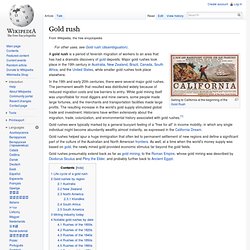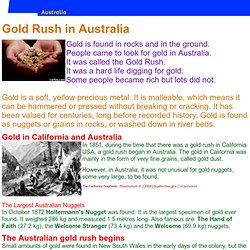

Australian Gold Rush. In fact they only got worse.

A powerfully disruptive hysteria seemed to grip the State along with the rest of the country. Farmhands simply left their employers with harvests they could no longer reap and thousands of workers fled Melbourne leaving empty industries in their wake. Wages tripled due to scarce labour. To raise money, many property owners put their houses on the market. But as there was no one interested in buying, house prices collapsed. Luckily however, this was not to last. And of course, lucky miners returning from the gold fields spent extravagantly easing the pressure on the suffering Melbourne. The incredible wealth that poured out of Victoria was unthinkable. Robert Coupe says in his book Australia's Gold Rushes (New Holland, 2000) that: "When the first reports of gold in the colonies were published in English newspapers late in 1851, few took much notice.
This wealth brought many imports and improvements to Australia. Gold rush. Sailing to California at the beginning of the Gold Rush A gold rush is a period of feverish migration of workers to an area that has had a dramatic discovery of gold deposits.

Major gold rushes took place in the 19th century in Australia, New Zealand, Brazil, Canada, South Africa, and the United States, while smaller gold rushes took place elsewhere. In the 19th and early 20th centuries, there were several major gold rushes. The permanent wealth that resulted was distributed widely because of reduced migration costs and low barriers to entry.
While gold mining itself was unprofitable for most diggers and mine owners, some people made large fortunes, and the merchants and transportation facilities made large profits. Gold rushes were typically marked by a general buoyant feeling of a "free for all" in income mobility, in which any single individual might become abundantly wealthy almost instantly, as expressed in the California Dream. Life cycle of a gold rush[edit] Australia[edit] American Experience. Australian gold rushes. An Australian gold diggings circa 1855 After the California gold rush began in 1848, causing many people to leave Australia for California to look for gold there, the New South Wales government rethought its position, and sought approval from the Colonial Office in England to allow the exploitation of the mineral resources and also offered rewards for the finding of payable gold.[2] The first gold rush in Australia began in May 1851 after prospector Edward Hargraves claimed to have discovered payable gold near Bathurst, at a site he called Ophir.[3] Hargraves had been to the Californian goldfields and had learned new gold prospecting techniques such as panning and cradling.

Hargraves was offered a reward by both the Colony of New South Wales and the Colony of Victoria. Australian gold rush timeline, HSIE, Discovering gold, Gold! Year 6, NSW. The first major mineral discovery - gold - was a watershed (a turning point or landmark) for Australian society.

The initial stages of the gold rush were responsible for tremendous changes in the community, bringing Australia's first great waves of immigration from countries other than England and Ireland. Ambitious prospectors from Asia, Europe and America made the trek to the goldfields of Ballarat and Bendigo in Victoria, and Bathurst in New South Wales, in the hope of striking it rich. This influx of people brought many social changes, including an increase in racial tensions with the persecution of some groups, notably the Chinese. Government Surveyor James McBrien discovers traces of gold in the Fish River, east of Bathurst.
Explorer and geologist Paul de Strzelecki discovers small amounts of gold in silicate near Hartley in the Blue Mountains. Gold! Gold Rush in Australia Gold is found in rocks and in the ground.

People came to look for gold in Australia. Gold rush. Australia's migration history timeline. Era: 1840 - 1900Cultural background: Chinese, EnglishCollection: Powerhouse MuseumTheme:Gold Government Labour Movement Miners Riots Settlement Licence for gold mining, 1853.

Courtesy of the Powerhouse Museum Collection Powerhouse Museum, Sydney, Australia. Object Name Gold Mining Licence. Object/Collection Description Licence for gold mining, framed, paper / wood / glass, issued to J McDonnell, printed by John Ferres, Government Printing Office, Victoria, Australia, 1853. In March 1851, Edward Hargraves wrote to the Sydney Morning Herald to announce that he had found payable gold just outside the New South Wales town of Bathurst. Lambing Flat miners’ camp, c.1860s Courtesy State Library of New South Wales With so many people leaving for the gold fields, many businesses found it hard to keep operating. Although there were some remarkable discoveries on the gold fields, few people made their fortune and most drifted back to towns and cities looking for work. Bibliography Websites. Find, mines, rewards, locations, South Australian Gold Rush.